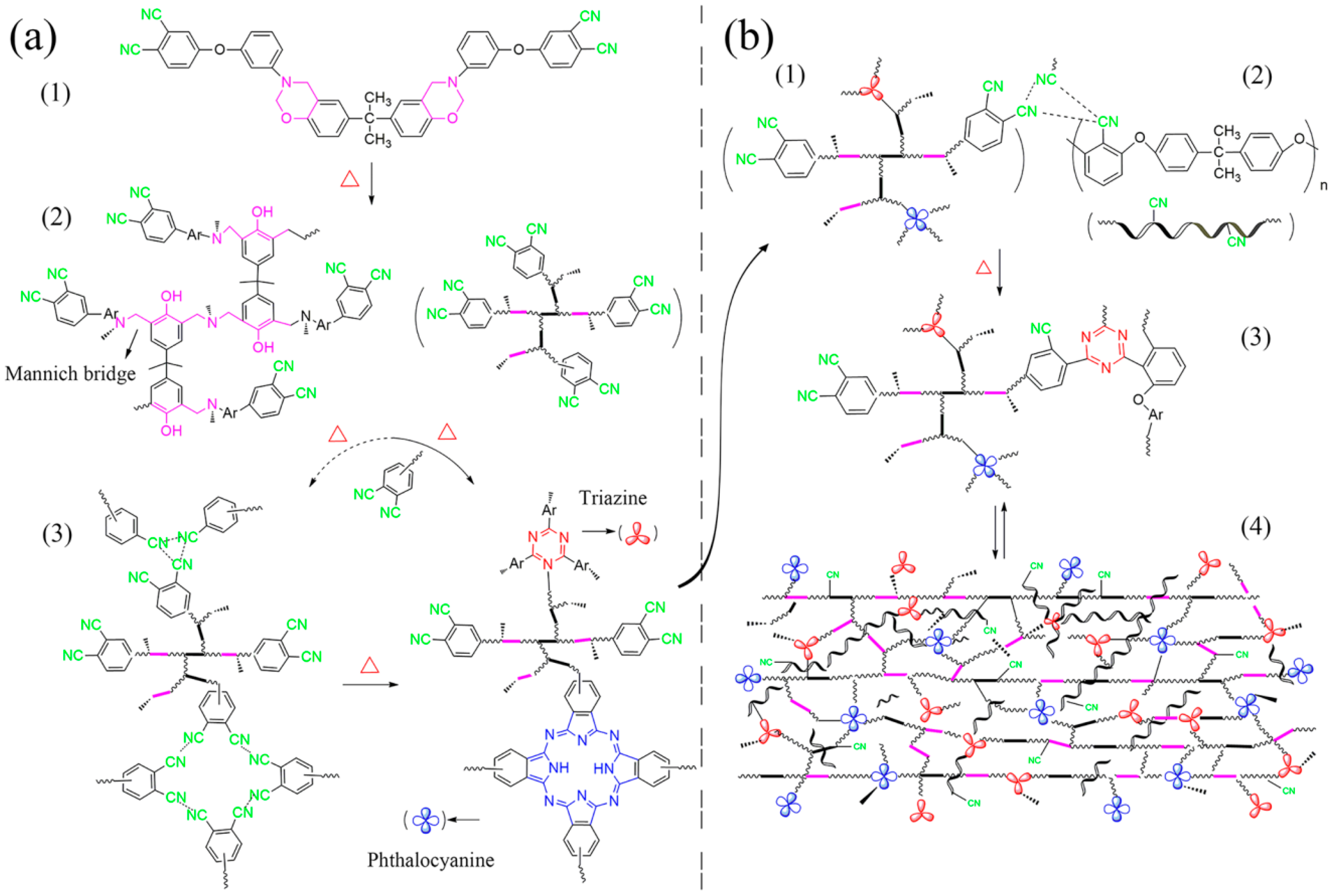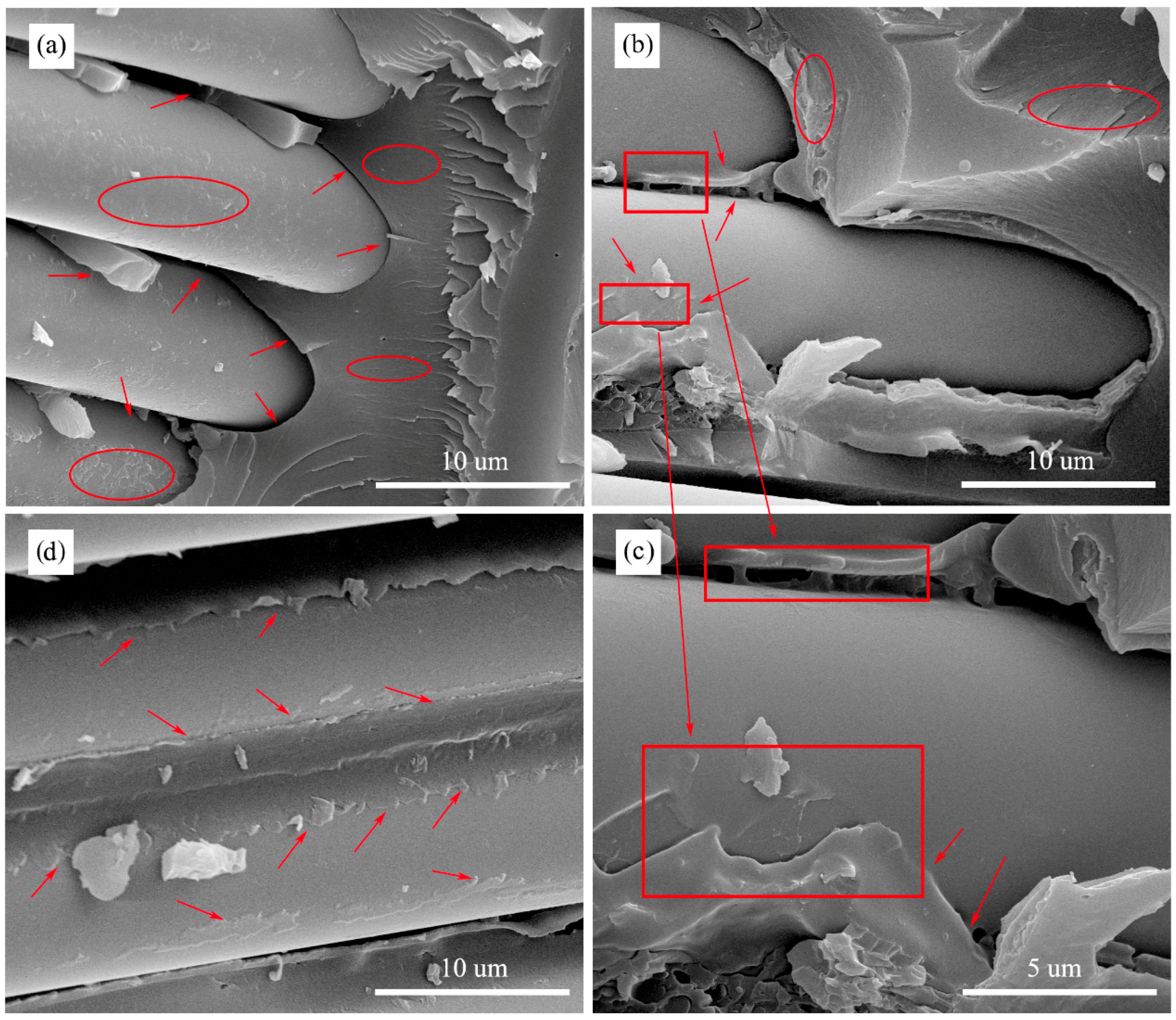Designing and Preparation of Fiber-Reinforced Composites with Enhanced Interface Adhesion
Abstract
:1. Introduction
2. Experimental
2.1. Materials
2.2. Preparation of PEN Modified Glass Fibers
2.3. Preparation of BA-ph/PEN Blends with Various Content of PEN
2.4. Preparation of BA-ph/PEN/p-GF Composite Laminates
2.5. Characterizations
3. Results and Discussion
3.1. Curing Behaviors of the BA-ph/PEN Blends
3.2. Mechanical Properties of the p-GF-Reinforced Composites
3.3. Fracture Morphology of the p-GF-Reinforced Composites
3.4. Dynamic Thermomechanical Analysis of the p-GF-Reinforced Composites
3.5. Thermal Properties of the p-GF-Reinforced Composites
4. Conclusions
Author Contributions
Funding
Acknowledgments
Conflicts of Interest
References
- Li, Y.; Li, N.; Gao, J. Tooling design and microwave curing technologies for the manufacturing of fiber-reinforced polymer composites in aerospace applications. Int. J. Adv. Manuf. Technol. 2014, 70, 591–606. [Google Scholar] [CrossRef]
- Liu, M.; Jia, K.; Liu, X. Effective thermal conductivity and thermal properties of phthalonitrile-terminated poly(arylene ether nitriles) composites with hybrid functionalized alumina. J. Appl. Polym. Sci. 2015, 132, doi. [Google Scholar] [CrossRef]
- Xu, M.; Hu, J.; Zou, X.; Liu, M.; Dong, S.; Zou, Y.; Liu, X. Mechanical and thermal enhancements of benzoxazine-based GF composite laminated by in situ reaction with carboxyl functionalized CNTs. J. Appl. Polym. Sci. 2013, 129, 2629–2637. [Google Scholar] [CrossRef]
- Ghosh, N.N.; Kiskan, B.; Yagci, Y. Polybenzoxazines-New high performance thermosetting resins: Synthesis and properties. Prog. Polym. Sci. 2007, 32, 1344–1391. [Google Scholar] [CrossRef]
- Derradji, M.; Wang, J.; Liu, W.-B. High performance ceramic-based phthalonitrile micro and nanocomposites. Mater. Lett. 2016, 182, 380–385. [Google Scholar] [CrossRef]
- Gupta, M.K.; Srivastava, R.K. Mechanical properties of hybrid fibers-reinforced polymer composite: A review. Polym.-Plast. Technol. Eng. 2016, 55, 626–642. [Google Scholar] [CrossRef]
- Xiong, L.; Zhan, F.; Liang, H.; Chen, L.; Lan, D. Chemical grafting of nano-TiO2 onto carbon fiber via thiol-ene click chemistry and its effect on the interfacial and mechanical properties of carbon fiber/epoxy composites. J. Mater. Sci. 2018, 53, 2594–2603. [Google Scholar] [CrossRef]
- Wu, W.; Wang, Q.; Ichenihi, A.; Shen, Y.; Li, W. The effects of hybridization on the flexural performances of carbon/glass interlayer and intralayer composites. Polymers 2018, 10, 549. [Google Scholar] [CrossRef]
- Domiguez, D.D.; Keller, T.M. Low-melting phthalonitrile oligomers: Preparation, polymerization and polymer properties. High Perform. Polym. 2006, 18, 283–304. [Google Scholar] [CrossRef]
- Dominguez, D.D.; Keller, T.M. Properties of phthalonitrile monomer blends and thermosetting phthalonitrile copolymers. Polymer 2007, 48, 91–97. [Google Scholar] [CrossRef]
- Sumner, M.J.; Sankarapandian, M.; McGrath, J.E.; Riffle, J.S.; Sorathia, U. Flame retardant novolac-bisphthalonitrile structural thermosets. Polymer 2002, 43, 5069–5076. [Google Scholar] [CrossRef]
- Xu, M.; Liu, M.; Dong, S.; Liu, X. Design of low temperature self-cured phthalonitrile-based polymers for advanced glass fiber composite laminates. J. Mater. Sci. 2013, 48, 8108–8116. [Google Scholar] [CrossRef]
- Zeng, K.; Zhou, K.; Zhou, S.; Hong, H.; Zhou, H.; Wang, Y.; Miao, P.; Yang, G. Studies on self-promoted cure behaviors of hydroxy-containing phthalonitrile model compounds. Eur. Polym. J. 2009, 45, 1328–1335. [Google Scholar] [CrossRef]
- Luo, Y.; Xu, M.; Pan, H.; Jia, K.; Liu, X. Effect of ortho-diallyl bisphenol a on the processability of phthalonitrile-based resin and their fiber-reinforced laminates. Polym. Eng. Sci. 2016, 56, 150–157. [Google Scholar] [CrossRef]
- Xu, M.; Yang, X.; Zhao, R.; Liu, X. Copolymerizing behavior and processability of benzoxazine/epoxy systems and their applications for glass fiber composite laminates. J. Appl. Polym. Sci. 2013, 128, 1176–1184. [Google Scholar] [CrossRef]
- Li, S.; Lin, Q.; Zhu, H.; Cui, C.; Hou, H.; Lv, T.; Li, Y. Investigations on mechanical characteristics of glass fiber reinforced epoxy composite modified with amino-terminated hyperbranched polymer. Fibers Polym. 2016, 17, 282–288. [Google Scholar] [CrossRef]
- Lin, F.; Li, W.; Tang, Y.; Shao, H.; Su, C.; Jiang, J.; Chen, N. High-performance polyimide filaments and composites improved by O2 plasma treatment. Polymers 2018, 10, 695. [Google Scholar] [CrossRef]
- Ren, D.; Lei, Y.; Pan, H.; Yan, L.; Xu, M.; Liu, X. Design of the phthalonitrile-based composite laminates by improving the interfacial compatibility and their enhanced properties. J. Appl. Polym. Sci. 2018, 135, 45811. [Google Scholar] [CrossRef]
- Cech, V.; Janecek, P.; Lasota, T.; Bursa, J. A fiber-bundle pull-out test for surface-modified glass fibers in gf/polyester composite. Compos. Interfaces 2011, 18, 309–322. [Google Scholar] [CrossRef]
- Sabet, S.M.; Mahfuz, H.; Terentis, A.C.; Nezakat, M.; Hashemi, J. Effects of POSS functionalization of carbon nanotubes on microstructure and thermomechanical behavior of carbon nanotube/polymer nanocomposites. J. Mater. Sci. 2018, 53, 8963–8977. [Google Scholar] [CrossRef]
- Jang, J.S.; Yang, H.J. The effect of surface treatment on the performance improvement of carbon fiber/polybenzoxazine composites. J. Mater. Sci. 2000, 35, 2297–2303. [Google Scholar] [CrossRef]
- Yan, F.; Liu, L.; Li, M.; Zhang, M.; Xiao, L.; Ao, Y. Preparation of carbon nanotube/copper/carbon fiber hierarchical composites by electrophoretic deposition for enhanced thermal conductivity and interfacial properties. J. Mater. Sci. 2018, 53, 8108–8119. [Google Scholar] [CrossRef]
- Jiang, B.; Zhu, A.; Zhang, C.; Li, Y. Interface enhancement between polytetrafluoroethylene and glass fibers modified with a titanate coupler. J. Appl. Polym. Sci. 2017, 134. [Google Scholar] [CrossRef]
- Jing, M.; Che, J.; Xu, S.; Liu, Z.; Fu, Q. The effect of surface modification of glass fiber on the performance of poly(lactic acid) composites: Graphene oxide vs. silane coupling agents. Appl. Surf. Sci. 2018, 435, 1046–1056. [Google Scholar] [CrossRef]
- Luo, G.; Li, W.; Liang, W.; Liu, G.; Ma, Y.; Niu, Y.; Li, G. Coupling effects of glass fiber treatment and matrix modification on the interfacial microstructures and the enhanced mechanical properties of glass fiber/polypropylene composites. Composites Part B 2017, 111, 190–199. [Google Scholar] [CrossRef]
- Tang, H.; Yang, J.; Zhong, J.; Zhao, R.; Liu, X. Synthesis and dielectric properties of polyarylene ether nitriles with high thermal stability and high mechanical strength. Mater. Lett. 2011, 65, 2758–2761. [Google Scholar] [CrossRef]
- Li, C.; Gao, N.; Liu, X. Compatibility, rheological, and thermal properties of the melt blends of PEN (HQ/PP) with PEN (HQ/RS). J. Appl. Polym. Sci. 2008, 108, 2934–2939. [Google Scholar] [CrossRef]
- Wan, X.; Zhan, Y.; Zeng, G.; He, Y. Nitrile functionalized halloysite nanotubes/poly(arylene ether nitrile) nanocomposites: Interface control, characterization, and improved properties. Appl. Surf. Sci. 2017, 393, 1–10. [Google Scholar] [CrossRef]
- Cao, G.P.; Chen, W.J.; Wei, J.J.; Li, W.T.; Liu, X.B. Synthesis and characterization of a novel bisphthalonitrile containing benzoxazine. Express Polym. Lett. 2007, 1, 512–518. [Google Scholar] [CrossRef]
- Yang, X.; Li, K.; Xu, M.; Jia, K.; Liu, X. Designing a low-temperature curable phenolic/benzoxazine-functionalized phthalonitrile copolymers for high performance composite laminates. J. Polym. Res. 2017, 24, 195. [Google Scholar] [CrossRef]
- Xu, M.Z.; Jia, K.; Liu, X.B. Effect of bisphenol-A on the structures and properties of phthalonitrile-based resin containing benzoxazine. Express Polym. Lett. 2015, 9, 567–581. [Google Scholar] [CrossRef]
- Zhao, L.; Hu, X. Autocatalytic curing kinetics of thermosetting polymers: A new model based on temperature dependent reaction orders. Polymer 2010, 51, 3814–3820. [Google Scholar] [CrossRef]
- Huang, Y.; Luo, Y.; Xu, M.; Lei, Y.; Liu, X. Studied on mechanical, thermal and dielectric properties of BPh/PEN-OH copolymer. Composites Part B 2016, 106, 294–299. [Google Scholar] [CrossRef]
- Qu, Z.-T.; Duan, S.-Y.; Li, B.-B.; Sun, D.; Gu, Y.-L. PDMS/PVDF microporous membrane with semi-interpenetrating polymer networks for vacuum membrane distillation. J. Appl. Polym. Sci. 2018, 135, 45792. [Google Scholar] [CrossRef]
- Cortes, L.Q.; Causse, N.; Dantras, E.; Lonjon, A.; Lacabanne, C. Morphology and dynamical mechanical properties of poly ether ketone ketone (PEKK) with meta phenyl links. J. Appl. Polym. Sci. 2016, 133. [Google Scholar] [CrossRef] [Green Version]
- Coulson, M.; Cortes, L.Q.; Dantras, E.; Lonjon, A.; Lacabanne, C. Dynamic rheological behavior of poly(ether ketone ketone) from solid state to melt state. J. Appl. Polym. Sci. 2018, 135, 46456. [Google Scholar] [CrossRef]
- James, J.; Thomas, G.V.; Pramoda, K.P.; Kalarikkal, N.; Thomas, S. Thermoplastic-elastomer composition based on an interpenetrating polymeric network of styrene butadiene rubber-poly(methyl methacrylate) as an efficient vibrational damper. New J. Chem. 2018, 42, 1939–1951. [Google Scholar] [CrossRef]








| Tg (°C) | Ti (°C) | Ttop1 (°C) | Ttop2 (°C) | ΔHcuring1 (J/g) | ΔHcuring2 (J/g) | |
|---|---|---|---|---|---|---|
| BA-ph | - | 166 | 226 | 268 | 61.22 | 60.11 |
| 10 wt % | - | 168 | 227 | 269 | 61.73 | 52.67 |
| 20 wt % | - | 168 | 230 | 270 | 69.64 | 35.32 |
| 30 wt % | - | 181 | 232 | 274 | 45.27 | 17.91 |
| 40 wt % | - | 181 | 233 | 275 | 51.02 | 13.77 |
| PEN | 178 | - | - | - | - | - |
| 0 wt % | 10 wt % | 20 wt % | 30 wt % | 40 wt % | |
|---|---|---|---|---|---|
| T5% (°C) | 315.14 | 293.94 | 276.41 | 256.17 | 270.79 |
| T10% (°C) | 397.32 | 377.96 | 367.01 | 367.7 | 358.43 |
| Char yield (%) | 65.61 | 63.27 | 61.41 | 63.51 | 53.53 |
© 2018 by the authors. Licensee MDPI, Basel, Switzerland. This article is an open access article distributed under the terms and conditions of the Creative Commons Attribution (CC BY) license (http://creativecommons.org/licenses/by/4.0/).
Share and Cite
Ren, D.; Chen, L.; Yuan, Y.; Li, K.; Xu, M.; Liu, X. Designing and Preparation of Fiber-Reinforced Composites with Enhanced Interface Adhesion. Polymers 2018, 10, 1128. https://doi.org/10.3390/polym10101128
Ren D, Chen L, Yuan Y, Li K, Xu M, Liu X. Designing and Preparation of Fiber-Reinforced Composites with Enhanced Interface Adhesion. Polymers. 2018; 10(10):1128. https://doi.org/10.3390/polym10101128
Chicago/Turabian StyleRen, Dengxun, Lin Chen, Yue Yuan, Kui Li, Mingzhen Xu, and Xiaobo Liu. 2018. "Designing and Preparation of Fiber-Reinforced Composites with Enhanced Interface Adhesion" Polymers 10, no. 10: 1128. https://doi.org/10.3390/polym10101128






